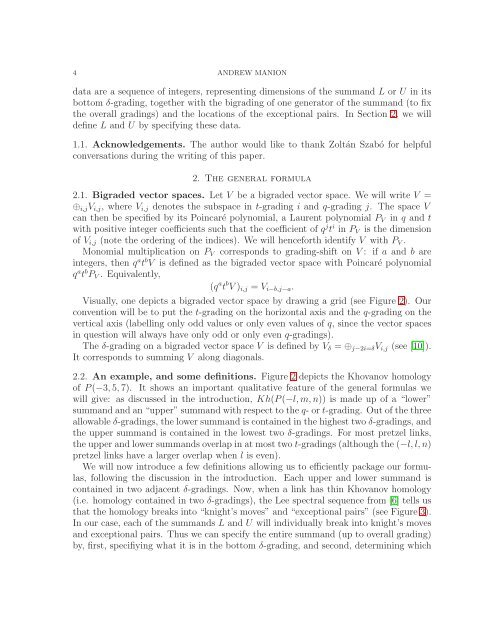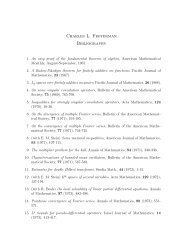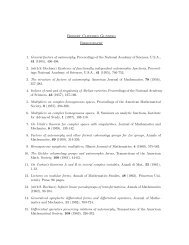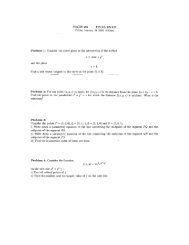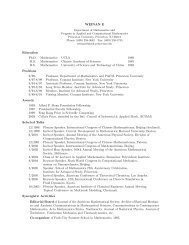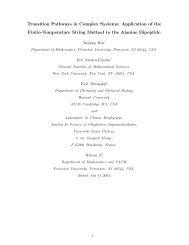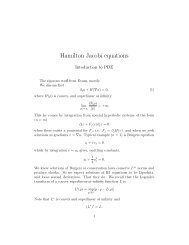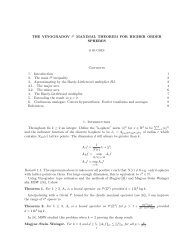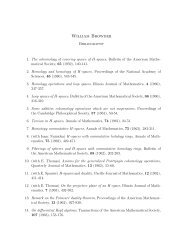The rational Khovanov homology of 3-strand pretzel links
The rational Khovanov homology of 3-strand pretzel links
The rational Khovanov homology of 3-strand pretzel links
Create successful ePaper yourself
Turn your PDF publications into a flip-book with our unique Google optimized e-Paper software.
4 ANDREW MANION<br />
data are a sequence <strong>of</strong> integers, representing dimensions <strong>of</strong> the summand L or U in its<br />
bottom δ-grading, together with the bigrading <strong>of</strong> one generator <strong>of</strong> the summand (to fix<br />
the overall gradings) and the locations <strong>of</strong> the exceptional pairs. In Section 2, we will<br />
define L and U by specifying these data.<br />
1.1. Acknowledgements. <strong>The</strong> author would like to thank Zoltán Szabó for helpful<br />
conversations during the writing <strong>of</strong> this paper.<br />
2. <strong>The</strong> general formula<br />
2.1. Bigraded vector spaces. Let V be a bigraded vector space. We will write V =<br />
⊕ i,j V i,j , where V i,j denotes the subspace in t-grading i and q-grading j. <strong>The</strong> space V<br />
can then be specified by its Poincaré polynomial, a Laurent polynomial P V in q and t<br />
with positive integer coefficients such that the coefficient <strong>of</strong> q j t i in P V is the dimension<br />
<strong>of</strong> V i,j (note the ordering <strong>of</strong> the indices). We will henceforth identify V with P V .<br />
Monomial multiplication on P V corresponds to grading-shift on V : if a and b are<br />
integers, then q a t b V is defined as the bigraded vector space with Poincaré polynomial<br />
q a t b P V . Equivalently,<br />
(q a t b V ) i,j = V i−b,j−a .<br />
Visually, one depicts a bigraded vector space by drawing a grid (see Figure 2). Our<br />
convention will be to put the t-grading on the horizontal axis and the q-grading on the<br />
vertical axis (labelling only odd values or only even values <strong>of</strong> q, since the vector spaces<br />
in question will always have only odd or only even q-gradings).<br />
<strong>The</strong> δ-grading on a bigraded vector space V is defined by V δ = ⊕ j−2i=δ V i,j (see [10]).<br />
It corresponds to summing V along diagonals.<br />
2.2. An example, and some definitions. Figure 2 depicts the <strong>Khovanov</strong> <strong>homology</strong><br />
<strong>of</strong> P(−3, 5, 7). It shows an important qualitative feature <strong>of</strong> the general formulas we<br />
will give: as discussed in the introduction, Kh(P(−l,m,n)) is made up <strong>of</strong> a “lower”<br />
summand and an “upper” summand with respect to the q- or t-grading. Out <strong>of</strong> the three<br />
allowable δ-gradings, the lower summand is contained in the highest two δ-gradings, and<br />
the upper summand is contained in the lowest two δ-gradings. For most <strong>pretzel</strong> <strong>links</strong>,<br />
the upper and lower summands overlap in at most two t-gradings (although the (−l,l,n)<br />
<strong>pretzel</strong> <strong>links</strong> have a larger overlap when l is even).<br />
We will now introduce a few definitions allowing us to efficiently package our formulas,<br />
following the discussion in the introduction. Each upper and lower summand is<br />
contained in two adjacent δ-gradings. Now, when a link has thin <strong>Khovanov</strong> <strong>homology</strong><br />
(i.e. <strong>homology</strong> contained in two δ-gradings), the Lee spectral sequence from [6] tells us<br />
that the <strong>homology</strong> breaks into “knight’s moves” and “exceptional pairs” (see Figure 3).<br />
In our case, each <strong>of</strong> the summands L and U will individually break into knight’s moves<br />
and exceptional pairs. Thus we can specify the entire summand (up to overall grading)<br />
by, first, specifiying what it is in the bottom δ-grading, and second, determining which


